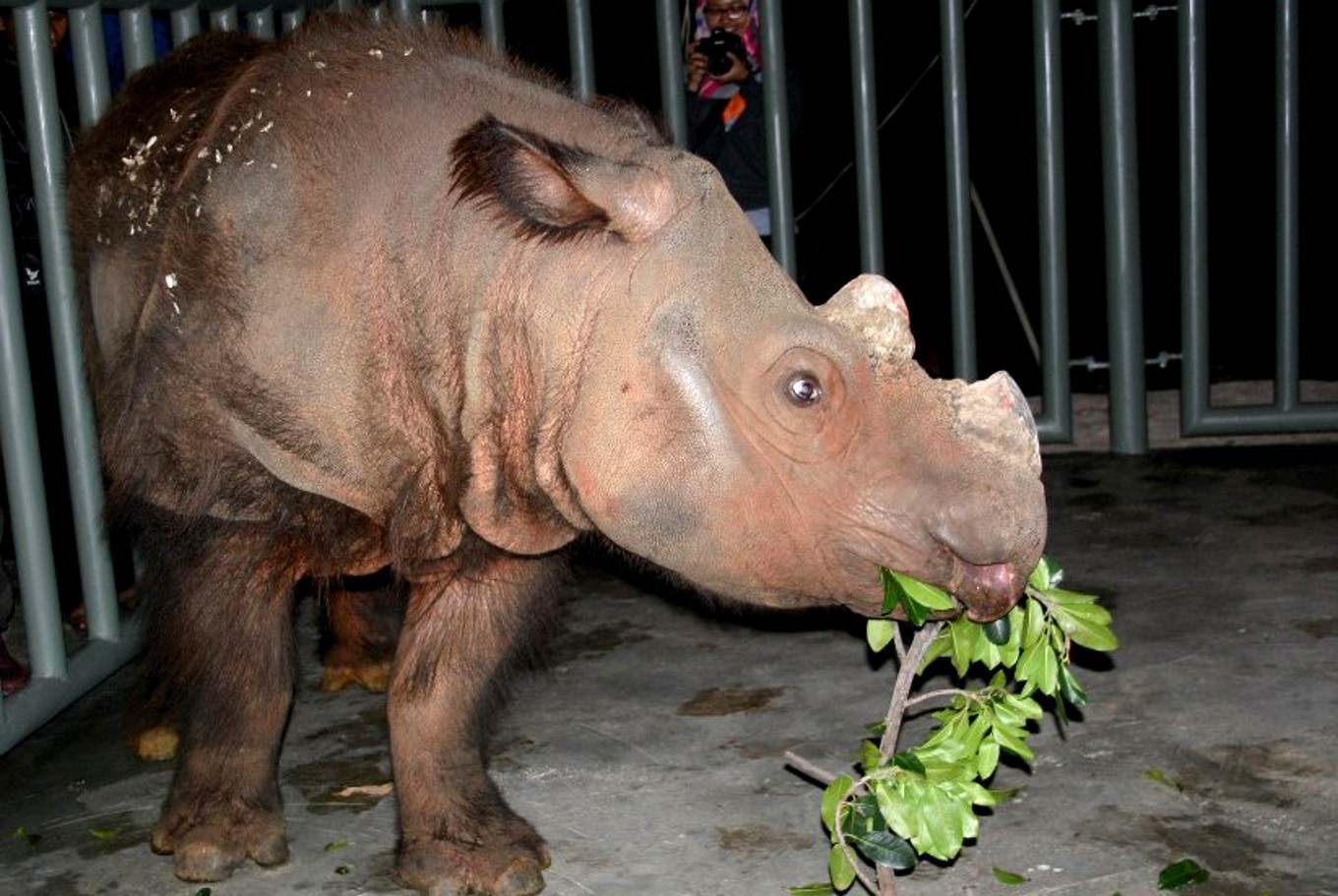Popular Reads
Top Results
Can't find what you're looking for?
View all search resultsPopular Reads
Top Results
Can't find what you're looking for?
View all search resultsSumatran rhino: Finding hope in the verge of obsolescence
Change text size
Gift Premium Articles
to Anyone
 Harapan, a young male Sumatran rhino, was born at the Cincinnati Zoo in 2007 to mother Emi and father Ipuh. Harapan spent time in three U.S. zoos over his first 8 years of life: the Cincinnati Zoo, White Oak Conservation Center in Florida, and the Los Angeles Zoo. (rhinos.org/International Rhino Foundation)
Harapan, a young male Sumatran rhino, was born at the Cincinnati Zoo in 2007 to mother Emi and father Ipuh. Harapan spent time in three U.S. zoos over his first 8 years of life: the Cincinnati Zoo, White Oak Conservation Center in Florida, and the Los Angeles Zoo. (rhinos.org/International Rhino Foundation)
S
ome great news shook the whole world as the International Rhino Foundation announced that Ratu — which means queen in Indonesian — was pregnant with her second calf and was scheduled to give birth soon in the first week of May.
Ratu is a female Sumatran rhino that had wandered out of the rainforest and had to be rescued before being brought to the Rhino Sanctuary in 2005.
In just a few more days, there will be an addition to the Sumatran rhino population that currently consists of just a few known individuals.
Back in 2012, Ratu gave birth to her first Sumatran calf, a male Sumatran rhino named Andatu, the first Sumatran rhino born in Indonesian captivity in more than 140 years.
(Read the first story: Sumatran rhino: A real threat of extinction in sight)
Andatu was a result of Ratu and Andalas — a 14-year-old male Sumatran rhino born at Cincinnati Zoo and moved to Indonesia in 2007. He has been separated from his mother, Ratu, and now has his own pen where he enjoys wallowing in mud and pulling down vines, excited at the prospect of being a big brother.
Rhinos have incredibly long gestation periods, ranging from 15-16 months, making it an animal with one of the longest gestation periods in the animal kingdom.
At the final stage of her pregnancy, Ratu spends her time in her makeshift rainforest enclosure; eating about 75-100 pounds of food each day and browsing through her rainforest enclosure for more food throughout the day and the night. Her keepers are preparing for the newborn calf by constructing a maternity enclosure and boma, which is complete and ready.
The Sumatran rhino population is currently estimated to be less than 100, making the species one of the most critically endangered animals in the world. The animals have roamed the earth for 50 million years but at the present moment, they can barely survive.
"Ratu’s incoming calf is a symbol of hope for the survival of the species."
Will the Sumatran rhinos thrive for the next generation? With proper poaching control and habitat conversion, the chance for them to breed can slowly recover; a process that will take decades.
Najaq, the Sumatran rhino that passed away a few weeks after being captured, caused many people in the world to bow their heads in grief. Najaq was living in a forest that was degraded due to nearby plantations and deforestation. She was caught in a pit trap after being sighted through camera traps, but eventually died in captivity after wounds left by a poaching trap led to an infection.
Ratu’s upcoming calf is like a kind of remedy and a second chance following Najaq’s death.
The International Rhino Foundation was launched to protect the many endangered species of rhino around the world and to support research on these large, majestic creatures. Without the care from people in the foundation, what would be the fate of rhinos?
Mabuya, the Black Rhino, would never have survived the relentless attacks from poachers. All the rhino orphans would either starve to death or be taken by those who intend to make profits. They would spend the rest of their lives balancing themselves in circuses or getting killed for their horns.
At the Sumatran Rhino Sanctuary, where Ratu and other rhinos currently reside, the foundation operates many Rhino protection units that actively patrol the country's national parks to discourage and stop poachers and deactivate threats.
Although the possibility of rhino extinction is discussed and advertised in slogans everywhere, it still does not stop poachers from going deep into rainforests to try and capture rhinos.
The rhino horn can be used as a trophy or sold as part of the herbal medicine trade. Despite the fact that it is now general knowledge that rhino horn is just made out of keratin and is not useful as a form of medicine at all, poachers continue to bring down the animals.
We learned lessons from the extinction of other species such as the Dodo Bird and the Stellar Sea Cow. At the current rate of poaching, rhinos could by extinct by 2026.
As Ratu prepares for the birth of her second calf and the whole world awaits for a hairy bundle of rhino hope, it is a chance for us to reflect on our actions and relationship with wildlife and mother nature.
In the pyramid of the ecosystem, every species counts.
***
Thirteen-year-old Elysa loves life science and literature dearly. She has been actively doing her part as a partner in supporting animal health and wildlife conservation. This article was written with the encouragement of the International Rhino Foundation. Elysa can be found on Twitter @elysa_ng or on her blog www.elysafaithng.wordpress.com.
---------------
Interested to write for Youth channel at thejakartapost.com? We are looking for information and opinions from students with appropriate writing skills. The content must be original on the following topics: passion, leadership, school, lifestyle ( beauty, fashion, food ), entertainment, science & technology, health, social media, and sports. Send your piece to community@jakpost.com, subject: YOUTH.






